
<< Back | Home | Site Map
Origin of name: Aboriginal - waterholes. Takes its name from an original pastoral run in the vicinity "Irriple".
Station opened: 27-10-1903
Distance from Melbourne (via Castlemaine): 347 miles 14 chains 35 links; 558.731 km
Distance from Melbourne (via Ballan): 565.635 km
Height above Sea Level: 147 feet
Irymple was one of the original stations opened when the line between Woomelang and Mildura was completed and open for traffic on 27-10-1903. A 200 feet long passenger platform, with two portable huts separated by a shelter shed, was provided. A loop siding on the site of No.3 road had a dead end extension at the up end to serve Chaffey and Hoops packing shed on leased land.
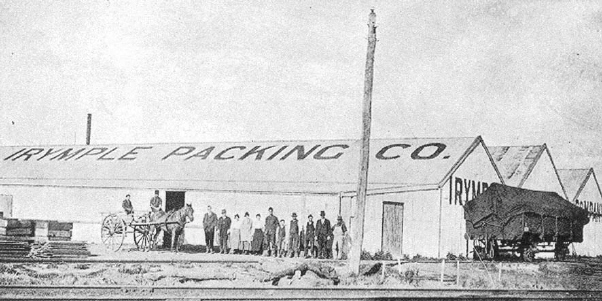
Employees pose outside the Irymple Packing Co. shed at Irymple. This was the first private siding to be provided, being opened with the line to Mildura in 1903. Photo: Bronwyn Zrna Collection
Prior to the opening of the line, Irymple Packing Co. Pty. Ltd. wrote to the department requesting a siding to their factory near the station. The department advised that the estimated cost of a siding would be one hundred and eighty pounds. The private siding was built at the down end of the yard leading off in the up direction, and was known as Roberts Siding. Irymple Packing Co. moved to the Irymple site in 1903/4 after three years on the corner of Benetook Avenue and 15th Street. Instructions were issued on 4-3-1904 for the siding to be spread with ballast to enable a horse employed by the company to move wagons to walk between the rails.
A siding for the Mildura Fruitgrower's Association was completed on 19-2-1904. It was built for one hundred and sixty six pounds eighteen shillings and seven pence. It was located a short distance from the down end of the yard with a 600 foot radius curve to serve the Mildura Fruitgrower's Association packing shed. (Later Mildura Co-operative Fruit Co. siding).
An extension was made to the passenger platform and a 30 x 20 goods shed was erected in 1904. A telegraph instrument was installed in 1904 and Limit Boards were erected in 1905 in lieu of signals.
The Mildura Fruitgrower's Association assigned their siding to the Mildura Co-Operative Fruit Co. Ltd. on 14-5-1906.
During 1906 engineers investigated the provision of a "skeleton shed" for the protection of fruit waiting to be loaded into trucks. It is most likely that the unique structure built on the goods platform was provided shortly after this time.
During their annual inspection tour in 1908, the Commissioners agreed to provide a ramp on the goods platform.
The "Mildura Cultivator" reported in January 1909 that "a man was to be put in charge of Irymple". An employee residence was constructed in 1905.

Another view of Robert's Irymple Packing Co., Irymple. The private siding was located alongside the building. This scene was probably taken about 1915 before the platform was extended. Note the firewood stacks and the wine barrels in the railway wagons. The barrels may have been required for W.B. Chaffey's Mildara Winery where the first wine grapes were planted in 1888. The winery transferred to Merbein in 1914. Photo: Bronwyn Zrna Collection
Disaster occurred on the night of Thursday 6-7-1911 when the two portable wooden huts that provided the station office and ladies waiting room were completely destroyed by fire. Operating Porter Mr. R.E.K. Marr (who had recently transferred to Irymple from Tallarook), found the buildings ablaze at 8.45 p.m.. There had been no fire in the office that day and there were suspicious circumstances as the fire was found to be burning from both ends of the wooden buildings. Mr. Marr, who slept on the premises, lost all his belongings except the clothes he was wearing. Although there were calls for a more commodious station building, the department saw fit to provide two standard 20 feet x 12 feet portable wooden huts as a replacement. Two spare portable huts were transferred from St. Arnaud in accordance with correspondence in departmental records dated 7-7-1911, the day after the fire. A third portable building was sent from Beulah and work was completed on 14-8-1911.
In December 1911, Irymple was opened as a safeworking staff station. Up and down home signals were not provided until 30-1-1912. No.2 road was built by 6-5-1912. A dead-end extension to No.3 road was added during 1912. The Mildura Co-operative Fruit Co. was fitted with a staff lock. Approval for removal of Location boards was issued on 14-3-1912.
A stationmaster was appointed from 25-3-1912 and another two departmental residences were provided.
On 21-3-1913, the Victorian Railways received an application from the Cowra Packing Co. for a private siding at Irymple. It appears that this was not proceeded with.
The passenger platform was extended by 180 feet and the goods platform extended by 60 feet by February 1915. It is possible that the station was extended at this time (1911-15) to meet the additional safeworking requirements and growth in passenger and goods traffic.
Electric staff working commenced between Red Cliffs - Irymple and Irymple - Mildura on 2-9-1925.
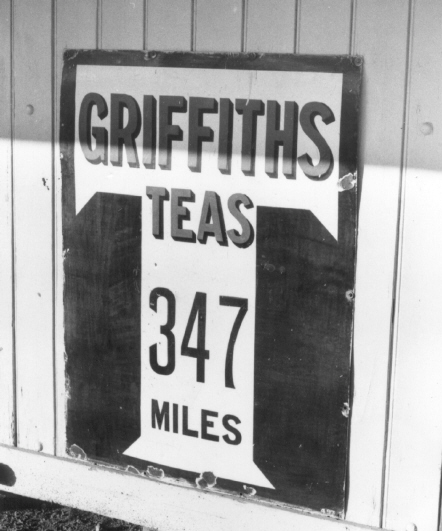
Griffiths Tea signs were famous along the railway lines of the Victorian Railways system marking each mile with an advertising sign. At Irymple, the 341 mile point was on the platform and this unusual sign was attached to the station building. It is now privately preserved. October 1974. Photo: Bruce McLean
The Irymple Packing Co. siding was extended by 38 feet on 15-2-1927 and another 100 feet on 7-11-1939. The Mildura Co-Op siding was also extended by 67 feet on 11-7-1933 with a further extension of 150 feet on 31-8-1948.
The up home signal was shifted out to a point nearer the 15th Street (Calder Highway) level crossing on 19-5-1943. Flashing light signals were installed on the signal posts at the 15th Street level crossing to warn motorists of an approaching train. An additional down home signal was also provided on the up side of the crossing on 27-5-1943.
A request by Irymple Packing Co. in 1943 for an occupation crossing to provide ready access between their property and Aurora Packing Co. was denied due to the cost of having to relocate the telephone line.
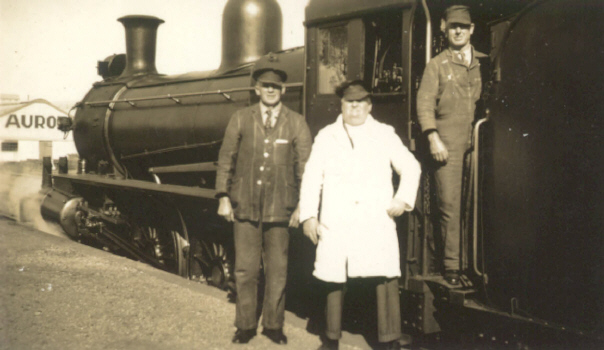
A D class locomotive and its crew at Irymple. The Aurora Packing Co. shed referred to in the text can be seen in the background. Photo: Bob Whitehead Collection
The Irymple Progress Association, in December 1945, approached the Victorian Railways Commissioners to seek the establishment of stock trucking yards at Irymple claiming the proximity to the abattoirs was an advantage.
During 1947, all wooden bridges over irrigation channels between Irymple and Mildura were replaced with concrete structures.
The dead-end siding at the down end of No.3 road was extended by 150 feet for use by Co-operative Dried Fruit Sales on 12-5-1953 and Irymple Packing Co. siding was extended a further 50 feet on 22-1-1957.
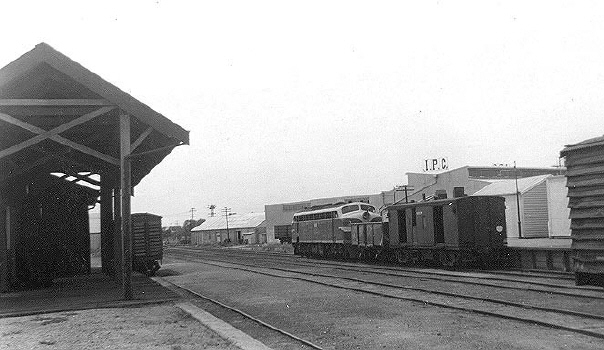
A B Class locomotive was assigned for the "Irymple Switch" - the daily task of shunting the Irymple yard and private packing shed sidings. The B and its short train are departing for Mildura. 1967. Photo: Bruce McLean
Flashing lights were installed at the Karadoc Avenue level crossing between Irymple and Mildura on 12-7-1967.
A spectacular collision between the down Mildura express and a fully laden fuel tanker on 28-4-1969 at the Irymple Avenue level crossing at the up end of the station yard resulted in the death of the train driver, and injuries to the train fireman, truck driver and a lady passenger. The locomotive (T398), Motorail wagon (AX7) and Sleeper No.1 were badly damaged. A fireball from the explosion also destroyed a departmental residence.
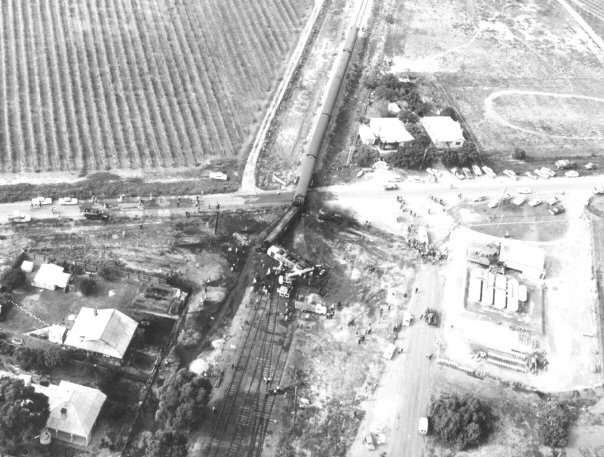
Aerial view of the result of a collision between a fully laden petrol tanker and the overnight train from Melbourne to Mildura when they collided at Irymple on 28-4-1969. Photo: Sunraysia Daily
Scotch Blocks which could be locked on or off the rails, were provided at each end of No.2 road by 3-2-1970. This would allow vehicles to be placed on No.2 road if there was not sufficient siding accommodation.
Under the keen supervision of Stationmaster Mr. D. McLaughlin and Assistant Stationmaster Mr. T. Kendall, Irymple station was judged the best station for maintenance of trees and gardens for the years 1971, 1972 and 1973 in the section for stations with piped water.
A corrugated iron pipe 48 foot long and 9 foot 6 inches diameter, one of the largest pipes handled in Sunraysia, was placed under the railway line near Morpung Avenue on the up side of Irymple on 3/4-8-1974. The pipe was to replace an open concrete irrigation channel for the First Mildura Irrigation Trust. Trains were not permitted to run between Redcliffs and Irymple from after the passage of "The Vinelander" to Mildura on the morning of 3-8-1974 until 4 p.m. on the following day.
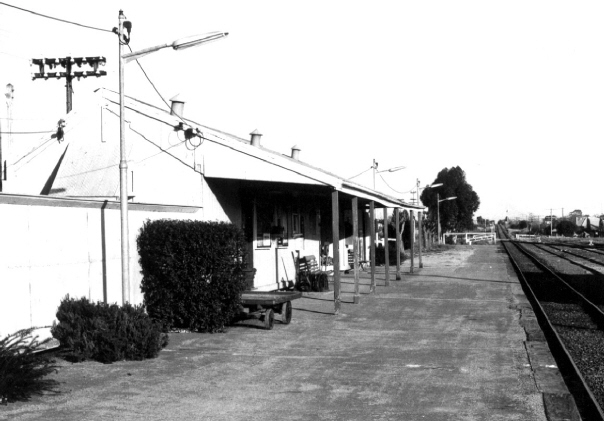
Irymple station and platform in October 1974. Irymple was a busy station at this time with high volumes of passenger and goods traffic. Photo: Bruce McLean
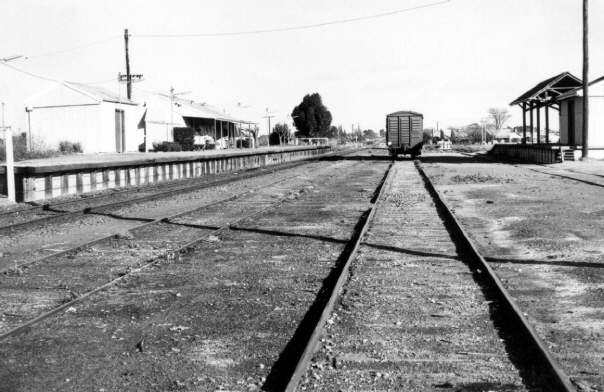
Irymple station and goods shed looking in the Up direction. October 1974. Photo: Bruce McLean
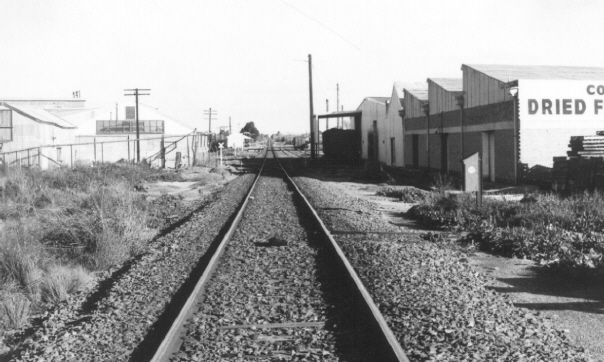
View approaching Irymple from the Mildura end. Sidings service local packing sheds with the Irymple Packing Co. on the left and Co-operated Dried Fruit Sales to the right. October 1974. Photo: Bruce McLean
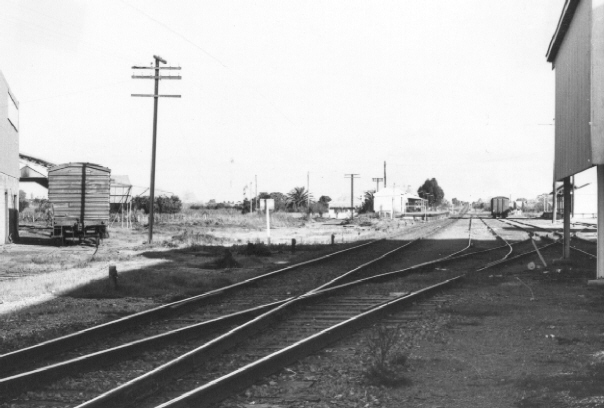
Looking in the Up direction. The IPC Siding leads off to the left. The canopy to the right protects loading of dried fruit at the Co-operated Dried Fruit Sales packing shed. October 1974. Photo: Bruce McLean
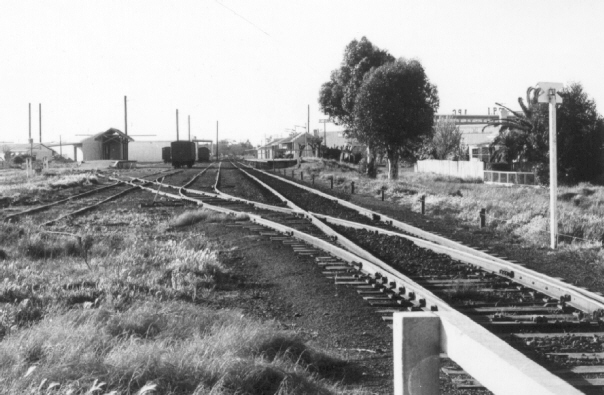
Irymple station and yard from the Up end. In the foreground is the site of the horrific collision between the down Mildura passenger train and a fully laden petrol tanker on 28-4-1969. October 1974. Photo: Bruce McLean
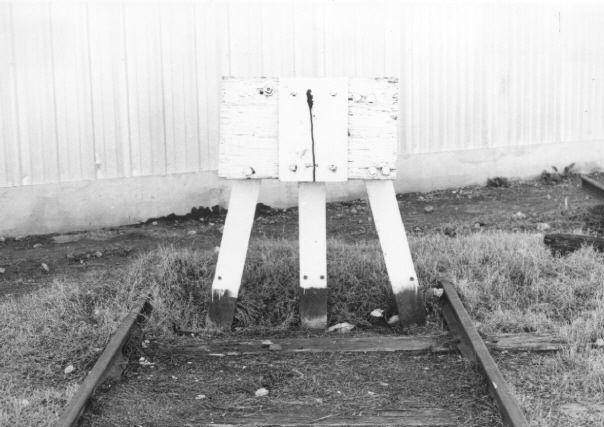
Unique steel buffer stop in Irymple yard at the down end of No. 3 road. The role of this device was to stop any wagon being propelled into the wall of the Co-operative Dried Fruit Sales packing shed. October 1974. Photo: Bruce McLean
The Calder Highway level crossing on the down side of Irymple was widened, traffic lanes duplicated and additional flashing light crossing signals installed by March 1976.
Following the opening of the Mildura Freight Centre on 4-12-1978, it was reported three months later that four jobs had been lost in the district following the closure of Merbein railway station and scaling down of operations at Redcliffs and Irymple. Staff at Irymple had been reduced to the Stationmaster with staff from Mildura or Redcliffs assisting on a part-time basis.
During early October 1979, the up end extension of No. 3 road was abolished and the compound points spiked to prevent movements onto the former siding.
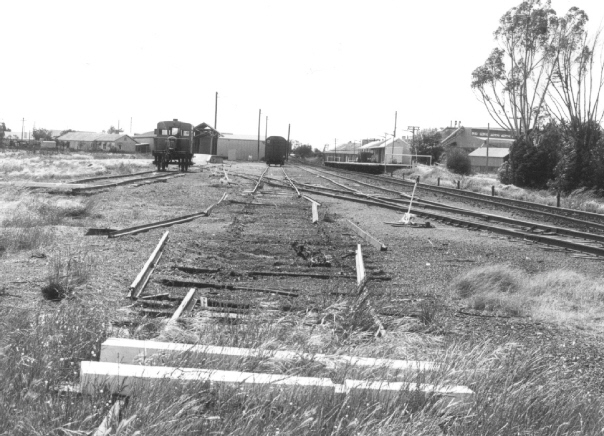
Work is underway dismantling the up end extension of No.3 road at Irymple on 6-10-1979. This siding was rebuilt after it was damaged when the down Mildura express collided with a fully laden petrol tanker on 28-4-1969. Locomotive T398 was tipped over onto its side and burnt out over the track with the driver killed. Photo: Bruce McLean
An upgrade of country passenger services was announced in February 1981, and provided for the closure of Irymple to passenger business (together with Lascelles and Tempy), to shorten travel time between Melbourne and Mildura. Predictably, this decision was criticised by Mildura Shire Council who pointed out that the draft timetable maintained the same arrival and departure times. The 1979/80 total of outward passenger journeys from the station was 688.
A meeting between VicRail representatives and Mildura City and Shire councils was held on 11-3-1981, to explain the new country passenger arrangements however no decision was made
on the future for Irymple passengers until August when it was advised that the station had been reprieved.
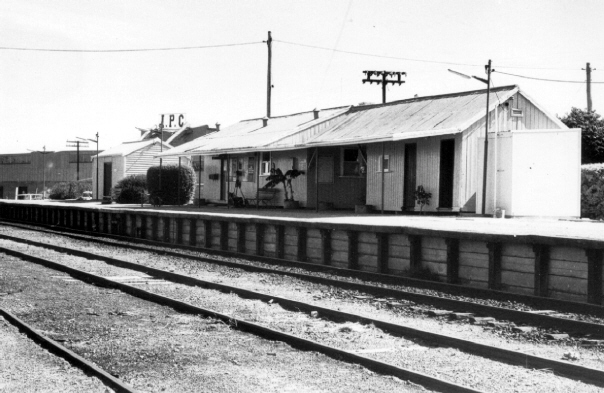
Irymple station about 1980. The Stationmaster, Mr. D. McLaughlan, took particular pride in the surroundings and the banana tree and shaped shrub on the platform are testimony to his enthusiasm. Photo: Bruce McLean
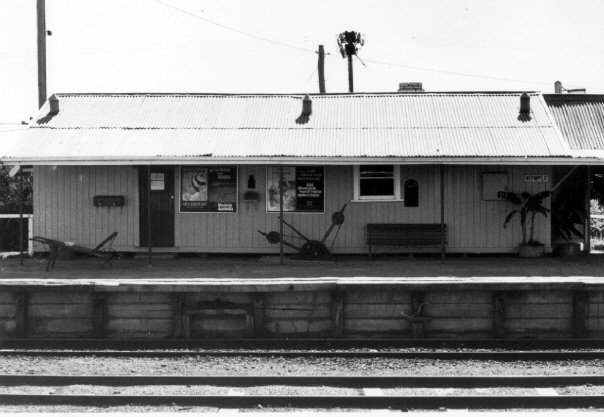
Another view of Irymple station office. The office consisted of two portable buildings joined together. Photo: Bruce McLean
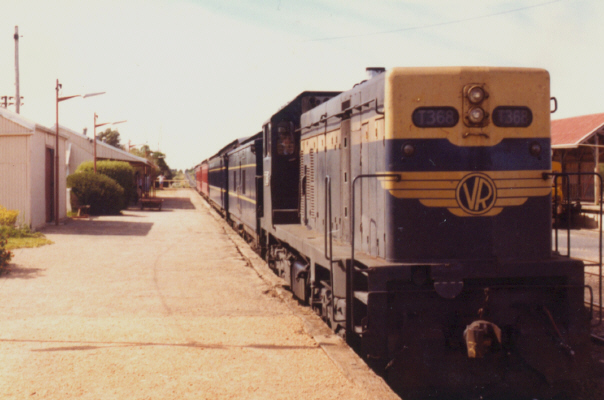
T368 arrives at Irymple station with a special train for the Australian Railway Exploration Association on 30-12-1981. Photo: Bruce McLean
During September 1983 Irymple station and platform parcels shed was repainted into turn-of-the-century heritage colors. It is not clear who initiated this idea, however the result was very pleasing as can be attested to in the accompanying photographs.
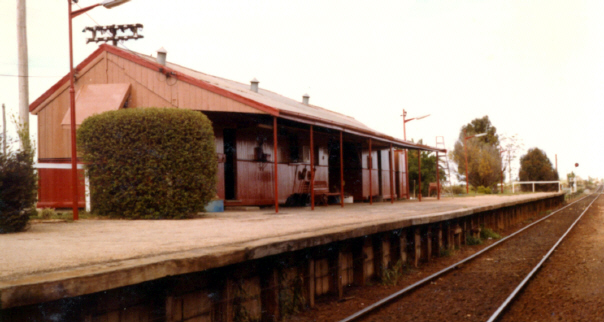
The "new look" Irymple station followings its transformation into heritage colors of light brown and red with a black band dividing the two colors. Note the neatly trimmed shrub. 19-9-1983. Photo: Bruce McLean
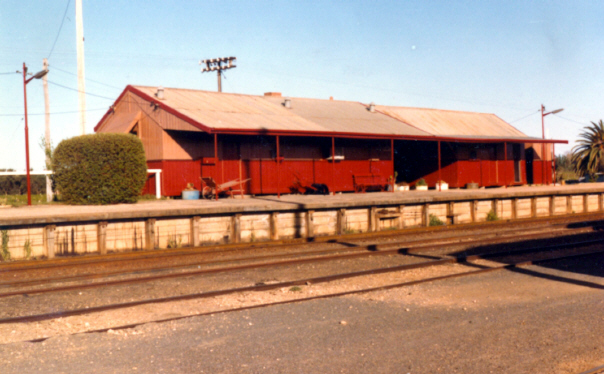
Irymple station following the completion of a repaint in heritage colors.21-9-1983. Photo: Bruce McLean
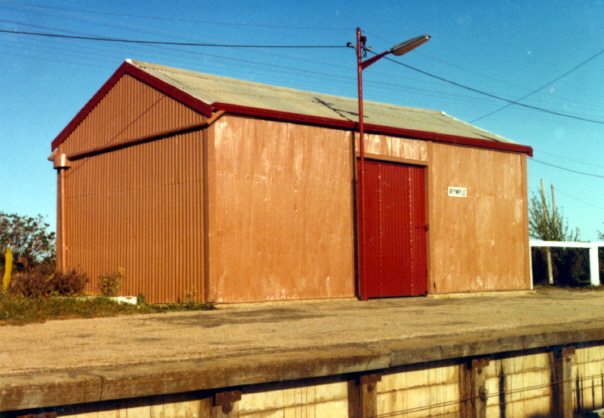
The parcels shed on the Irymple platform was also treated in heritage colors from the turn of the century. 21-9-1983. Photo: Bruce McLean
At some time before 1983, an extension was added to the Irymple Packing Co. siding. This was mainly to cater for the introduction of longer container wagons and involved the removal of several rows of vines from the company vineyard. The appearance of railway wagons loaded with containers in the middle of a vineyard presented a most unusual sight to a casual observer.
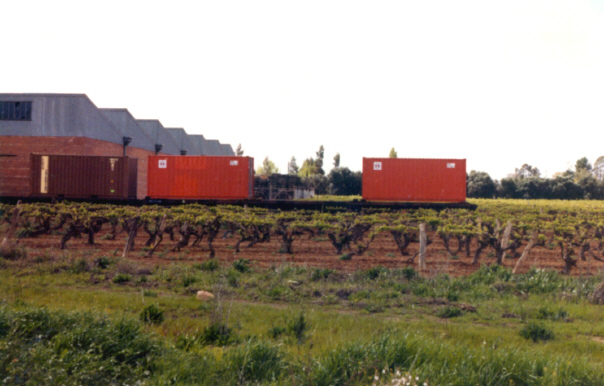
The unusual effect of a siding extending into the Irymple Packing Co. vineyard with container wagons for export dried fruit. 19-9-1983. Photo: Bruce McLean
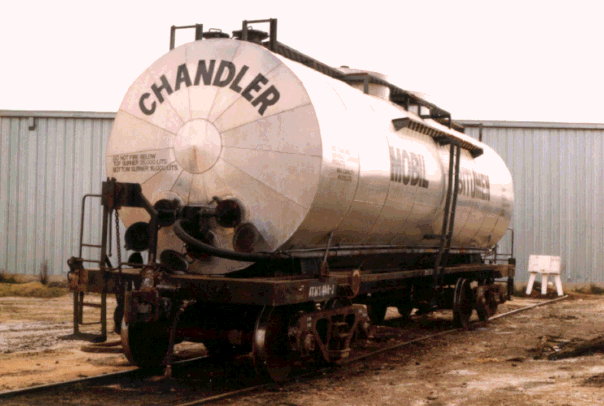
The Shire of Mildura sourced their bitumen requirements from the Mobil Oil company who used a series of rail tankers for distribution of their product. On this occasion ATMX 448 "Chandler" is stabled at the up dead end siding off No.4 road at Irymple. 21-9-1983. Photo: Bruce McLean
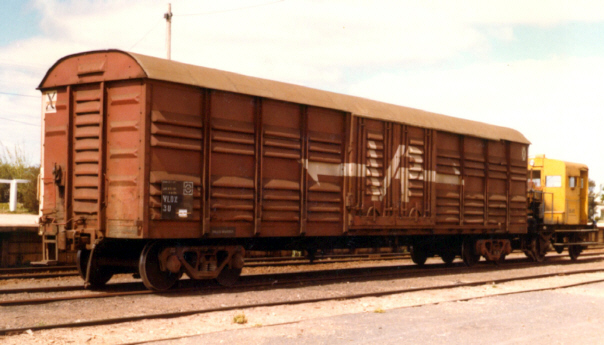
A shunting tractor was located at Irymple for the movement of wagons to the various private sidings serving dried fruit packing sheds. Here we see Rail Tractor RT26 attached to VLDX3. Wagons at Irymple were either picked up by a daily shunting trip from Mildura or by the "Fruit Flier" en route to Melbourne each afternoon. 21-9-1983. Photo: Bruce McLean
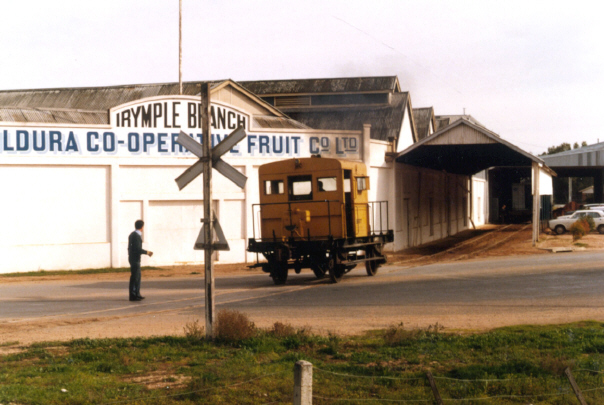
The Mildura Co-operative siding was opened in 1903/4 when the railway to Mildura was open for traffic. Rail tractors placed at Irymple have been used to transfer rolling stock to and from the siding. In this scene rail tractor 8RT is crossing Koorlong Avenue to collect a container wagon. 31-7-1986. Photo: Bruce McLean
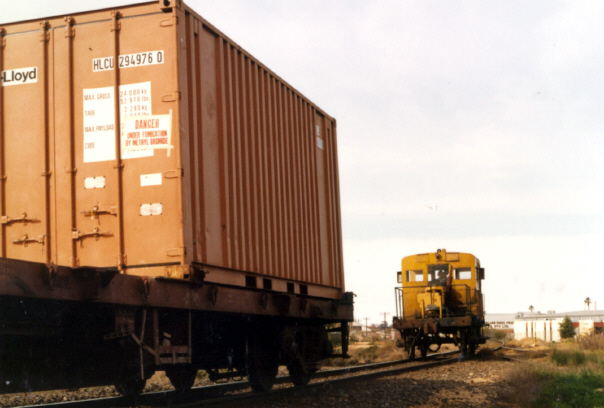
8RT prepares to attach to a container wagon standing on the main line during its shunting operation at the Mildura Co-operative Fruit Company siding. The points leading into the packing shed are behind the rail tractor. 31-7-1986. Photo: Bruce McLean
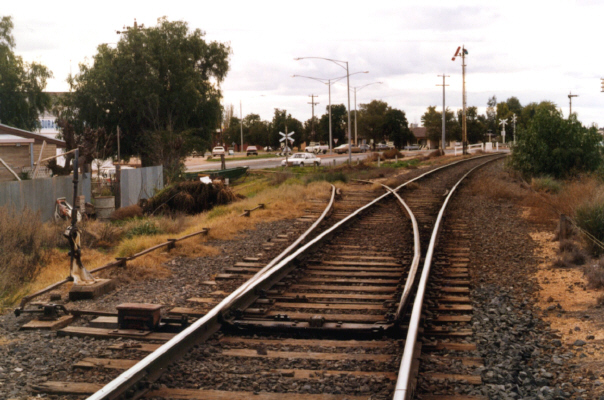
The points leading to the Mildura Co-operative Fruit Company siding at Irymple. The Down departure signal can also be observed near the Calder Highway level crossing. 31-7-1986. Photo: Bruce McLean
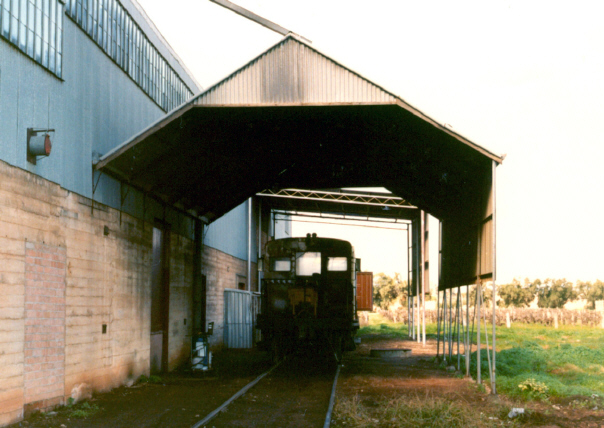
The Irymple Packing Company private siding was also shunted by the Irymple rail tractor. Here we see 8RT under canopies that cover the loading bays with container wagons for export dried fruit.31-7-1986. Photo: Bruce McLean
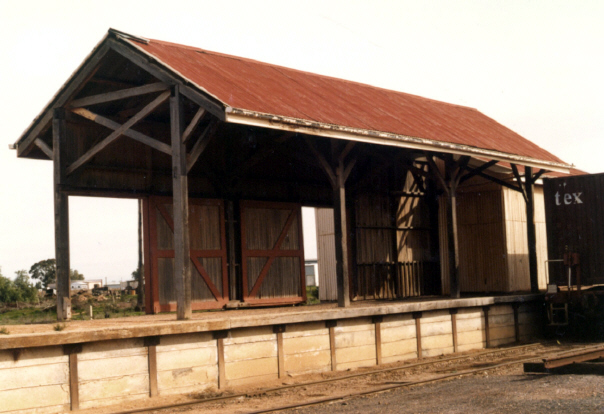
The unique fresh fruit shed located on the goods platform at Irymple. 31-7-1986. Photo: Bruce McLean
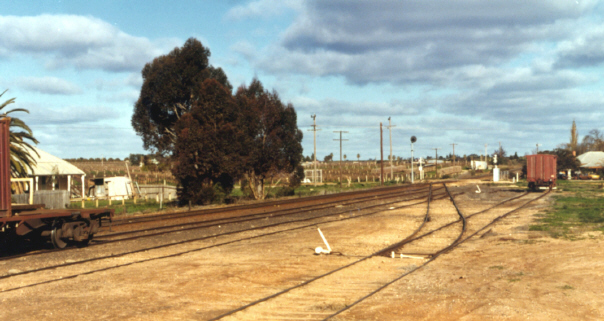
The Up end of Irymple railway yards. 27-7-1986. Photo: Bruce McLean
Removal of the compound points at each end of the Irymple yards was carried out during August and September 1986.
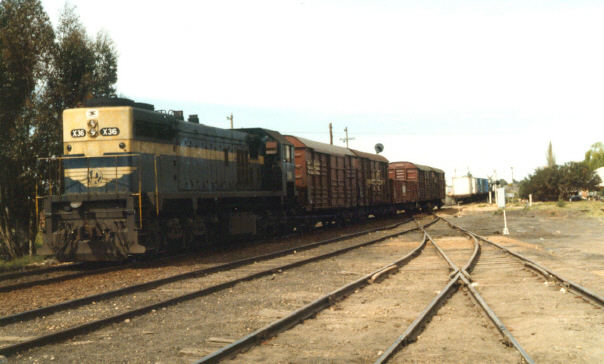
The new track arrangement at the Up end of Irymple following the removal of the compound points. The dead end siding off No.3 road was removed in 1979. X34 has paused at the station to undertake wagon shunting. 11-9-1986. Photo: Bruce McLean
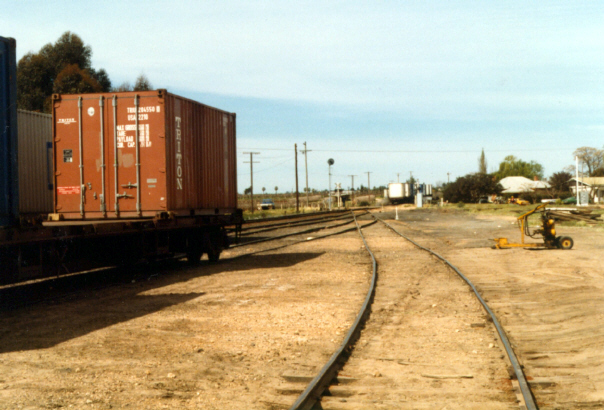
The dead end extension to No.4 road was also removed during the track rationalisation work at Irymple. 11-9-1986. Photo: Bruce McLean
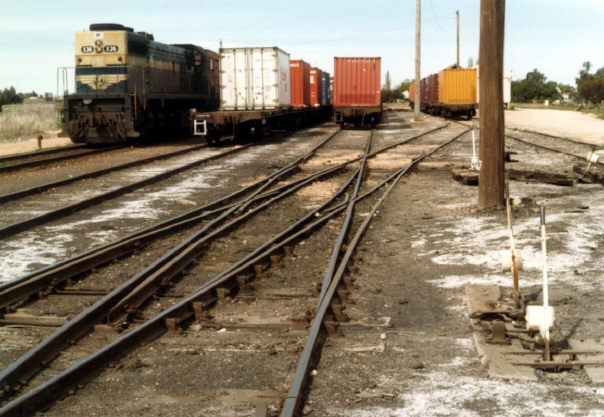
The down end compound points at Irymple shortly before their replacement. The white covering on the ground is naturally occurring salt. X34 is shunting the station yard giving an indication of the very high level of tonnage despatched from the Irymple packing sheds. 11-9-1986. Photo: Bruce McLean
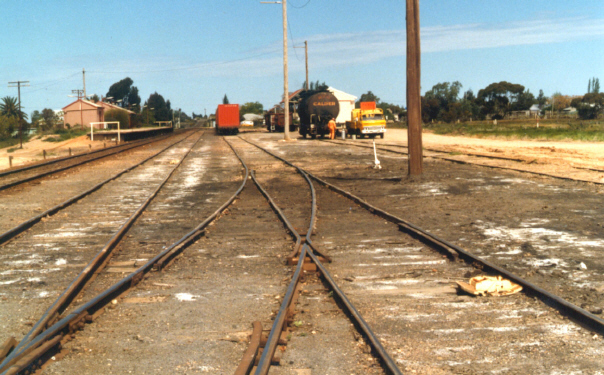
By 28-9-1986 the compound points had been removed and replaced with a simple turnout. The connection across to No.4 road was removed and No.4 road was made a dead-end siding from the Up end. Photo: Bruce McLean
In January 1987 Mildura Shire Council was informed that Irymple would be disestablished with no one in attendance for passenger and parcels traffic. The close proximity of Mildura was one reason advanced in the decision to rationalise services to make V/Line more competitive. This was subsequently denied by a senior V/Line official when the Shire complained, however it was advised that the new daylight passenger train service would not be stopping at the station when it replaced the overnight "The Vinelander" on three days. The Shire was keen to keep Irymple open, but V/Line wanted a minimum of 20 passengers to travel too or from the station on at least 50 percent of trains scheduled to stop. V/Line confirmed in September 1987 that the station would remain open but subject to review at any time. Between February and May 1987 an average of only 9 passengers a week used the station on 48% of services.
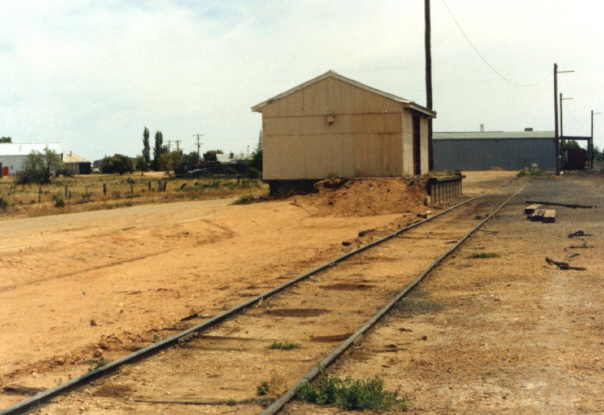
The unique fruit shed on the goods platform at Irymple was removed together with part of the goods platform in November 1987. Photo: Bruce McLean
On 15-10-1990, the Calder Highway level crossing was equipped with cantilever masts and strobe lights.
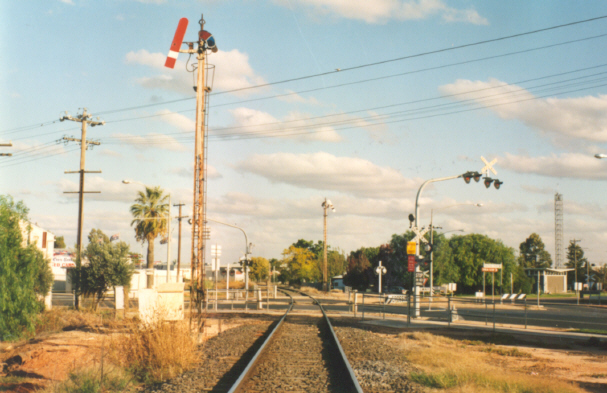
The down end home signal facing up trains arriving at Irymple was located next to the Calder Highway level crossing. 30-5-1993. Note the cantilever masts holding the strobe lights as an additional aid to warn motorists of on-coming trains. Photo: Bruce McLean
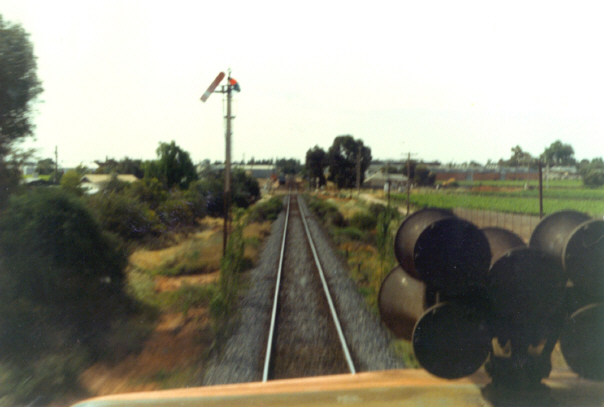
The Up end home signal at Irymple from the cabin of locomotive X42. 20-10-1991. Photo: Bruce McLean
The withdrawal of Mildura line rail passenger services by the Kennett government on 12-9-1993 diminished the role of Irymple station with supervision and goods operations being undertaken by Mildura staff, although this had been the case for some time beforehand.
The IPC Siding was officially taken out of service on 26-3-1996. From 1-3-1996, Wakefield's Transport of Merbein, were contracted by V/Line to supply and pick up containers at packing sheds at Irymple, Redcliffs, Mildura and Merbein, locations where the packing shed companies had their own sidings. The containers are moved by road to Merbein for loading onto rail wagons.
In April 1996, the Rail Tractor (RT29) was withdrawn from Irymple and sent to Dynon. It was to return later in the year to Mildura where it was stabled in the carriage shed pending commencement of an intermodal operation at Irymple. The project did not eventuate and RT29 returned to Melbourne on 5-12-1996.
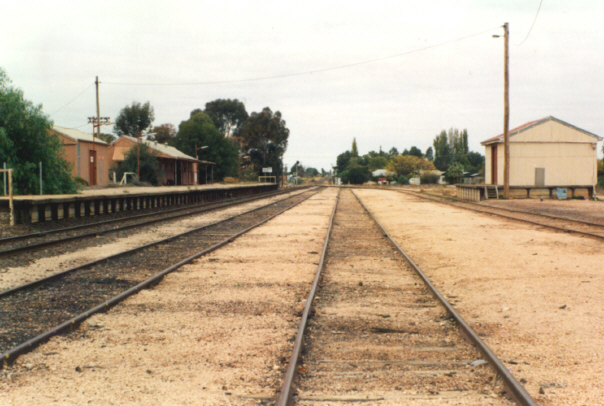
Irymple station yard looking in the Up direction. 8-6-1996. Photo: Bruce McLean
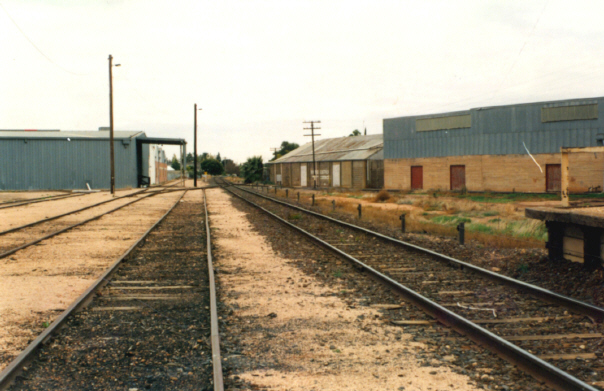
Irymple station yard looking in the Down direction. The Irymple Packing Co. siding is to the right, alongside the packing shed building. The sidings at Irymple ceased to be used with the establishment of Merbein as an intermodal operation centre for V/Line Freight in 1996. The rail tractor was withdrawn from Irymple at this time. 8-6-1996. Photo: Bruce McLean
Freight Victoria reintroduced Train Order Working on the Mildura corridor from 25-7-1999. Irymple was only recognised as a siding for the section Yatpool Block Point - Mildura. In November 1999, the Up and Down end points on the main line were spiked inoperable, thus rendering Irymple effectively closed, but not officially closed.
It was the beginning of a process of decay for the station and its facilities.
On 12-4-2001, the Minister for Planning, Mr. J. Thwaites, announced the fifth round of grants from the Public Heritage Program administered by Heritage Victoria. Irymple's disused station was granted an amount of $40,000 for stabilisation and repair work to be undertaken, however the report was inaccurate in claiming that the building was the original 1903 station.
The Member for Mildura, Mr. R. Savage, whilst originally welcoming the grant, considered that the isolated position of the station would continue to make it vulnerable for vandalism unless it was permanently occupied. He suggested that the station could be moved to the Red Cliffs Historical Steam Railway site at Red Cliffs where it would be of benefit to the organisation as a station building and preserved by railway enthusiasts as part of a working railway line. This move was supported by members of the Irymple Progress Association and the Lions Club of Irymple who had previously restored the station building. Representatives from Heritage Victoria inspected the station building in April 2001 in response to the suggestion.
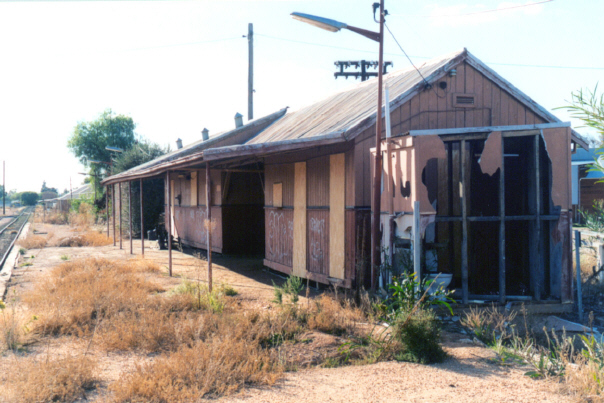
The derelict condition of Irymple railway station on 1-7-2001. Restoration of the isolated station on the site would have resulted in further damage by vandals and a waste of heritage funding. Photo: Bruce McLean
Following Mr. Savage's representations to Heritage Victoria, an application was made to remove the station, however this was not supported by the National Trust and Heritage Victoria were reluctant to issue a permit for removal. On 30-7-2001, the author provided Mr. Savage with a history of the station including evidence that the station building referred to was not the original 1903 structure. Following further representations by Mr. Savage, Heritage Victoria granted a permit under the Heritage Act on 17-8-2001 for the station building to be moved to Red Cliffs.
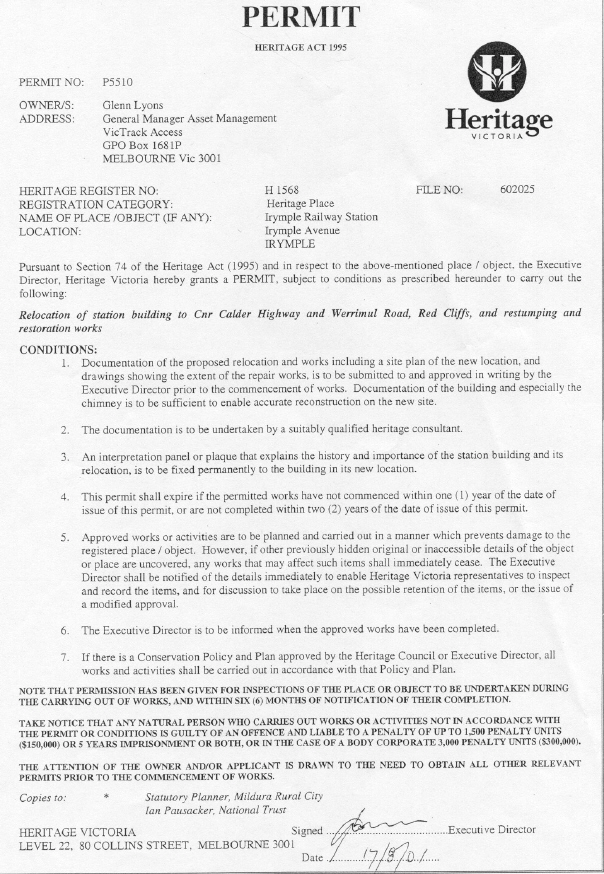
Permit issued by Heritage Victoria for removal of Irymple railway station building to the Red Cliffs Historical Steam Railway site at Red Cliffs for preservation. Courtesy: Russell Savage M.L.A.
Deputy Premier Mr. J. Thwaites visited Mildura on 19-10-2001 and inspected the Irymple station building with Mr. Savage and representatives of the Redcliffs Historical Steam Railway, Mr. M. Hopkins, Mr. R. Collins and the author. Mr. Thwaites stated that "Irymple is one of Victoria's more humble railway stations, which is part of its attraction" and agreed that the proposed move to Redcliffs would be a "creative and flexible solution to the problem of under-use, decay and vandalism".
With the necessary approvals and permits in place, and receipt of the heritage grant, members of the Redcliffs Historical Steam Railway began the task of preparing the buildings for removal on 3-2-2002.
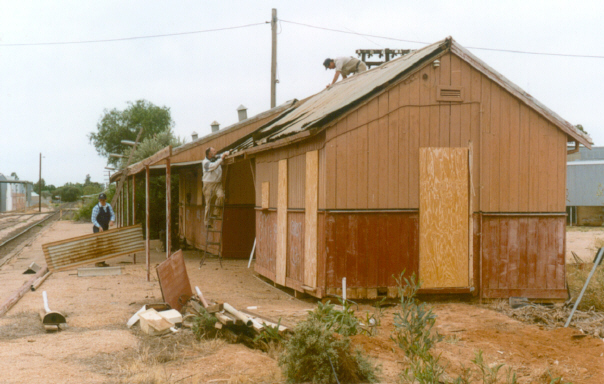
Members of the Redcliffs Historical Steam Railway preparing the Irymple station buildings for transportation to Redcliffs for restoration with the assistance of a Heritage grant. 3-2-2002. Photo: Bruce McLean
The buildings were removed from Irymple to the Redcliffs Historical Steam Railway site on 24-5-2002 by house removalists Mills and Scherger.
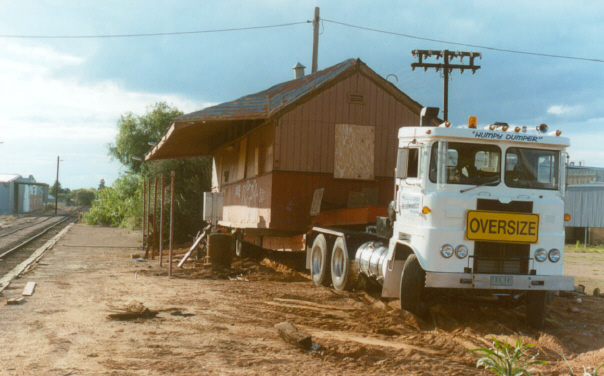
The main part section of the Irymple station building is mounted on the removalist truck for transfer to Redcliffs Historical Steam Railway site. 24-5-2002. Photo: Bruce McLean
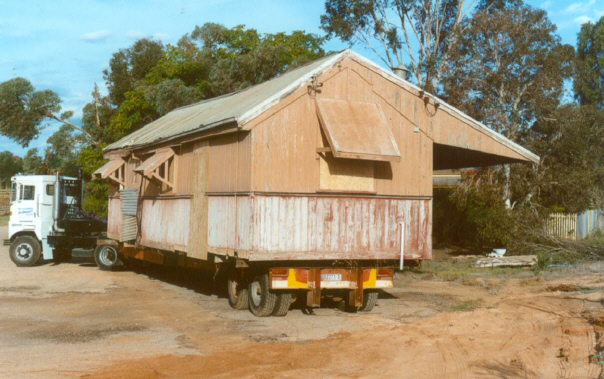
The station building is on the move to Redcliffs. 24-5-2002. Photo: Bruce McLean
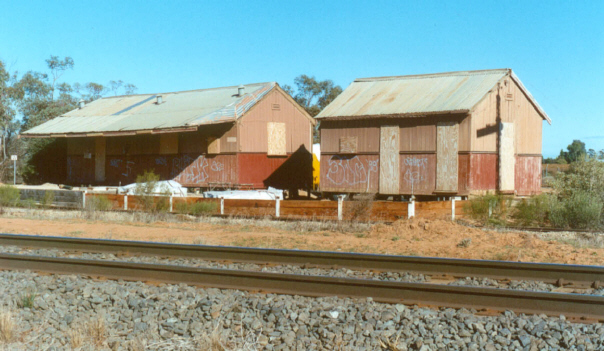
The station buildings placed at their new home on the Redcliffs Historical Steam Railway reserve at Redcliffs, overlooking the Melbourne to Mildura main line. A heritage grant of $40,000 was given to the group to restore the station. 1-6-2002. Photo: Bruce McLean
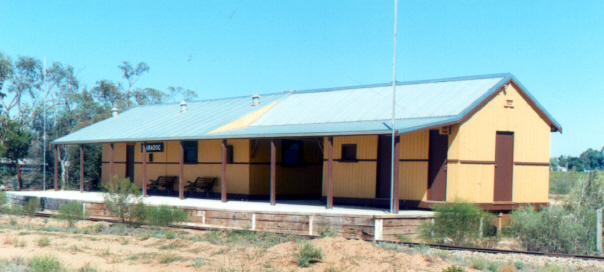
Irymple station following restoration by Redcliffs Historical Steam Railway. 16-3-2003. Photo: Bruce McLean
Following completion of the restoration, the station was officially opened at the new site by Member for Mildura, Mr. R. Savage, on 5-4-2003. The station was renamed "Karadoc" as this was the proposed name for a station reserve on the adjacent Melbourne to Mildura railway line.

Irymple station viewed from the passenger entrance side. 16-3-2003. Photo: Bruce McLean
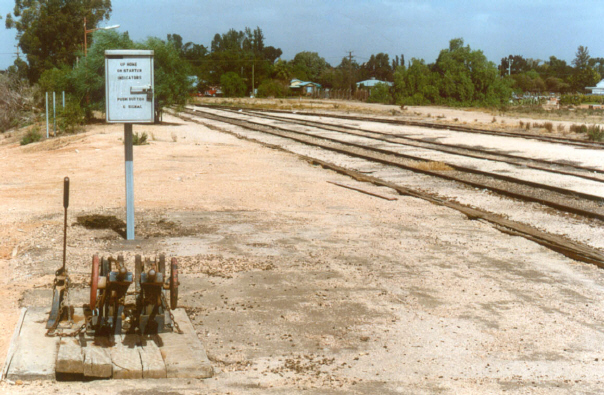
Irymple station following removal of the station building. The levers are retained for operating mechanical signals and the stainless steel box contains controls for the light signal at the Up end and level crossing lights. 14-4-2003. Photo: Bruce McLean
| << Back | Home | Site Map | Copyright © 2003 Bruce McLean, All Rights Reserved |